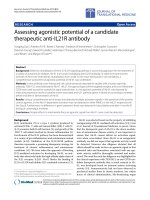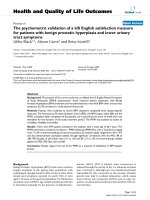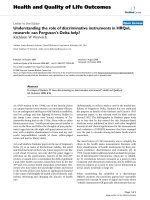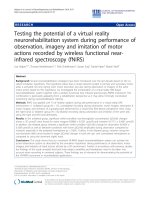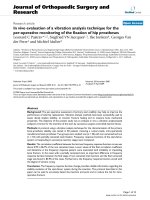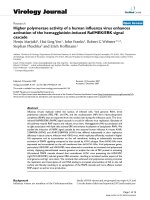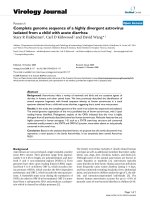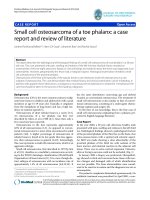Báo cáo hóa học: "Design and implementation of a real time and train less eye state recognition system" docx
Bạn đang xem bản rút gọn của tài liệu. Xem và tải ngay bản đầy đủ của tài liệu tại đây (1.3 MB, 28 trang )
This Provisional PDF corresponds to the article as it appeared upon acceptance. Fully formatted
PDF and full text (HTML) versions will be made available soon.
Design and implementation of a real time and train less eye state recognition
system
EURASIP Journal on Advances in Signal Processing 2012,
2012:30 doi:10.1186/1687-6180-2012-30
Mohammad Dehnavi ()
Mohammad Eshghi ()
ISSN 1687-6180
Article type Research
Submission date 22 May 2011
Acceptance date 15 February 2012
Publication date 15 February 2012
Article URL />This peer-reviewed article was published immediately upon acceptance. It can be downloaded,
printed and distributed freely for any purposes (see copyright notice below).
For information about publishing your research in EURASIP Journal on Advances in Signal
Processing go to
/>For information about other SpringerOpen publications go to
EURASIP Journal on Advances
in Signal Processing
© 2012 Dehnavi and Eshghi ; licensee Springer.
This is an open access article distributed under the terms of the Creative Commons Attribution License ( />which permits unrestricted use, distribution, and reproduction in any medium, provided the original work is properly cited.
Design and implementation of a real time and train less eye state
recognition system
Mohammad Dehnavi*
1
and Mohammad Eshghi
1
1
ECE Department, Shahid Beheshti University, Tehran, Iran
*Corresponding author:
Email address:
MD:
ME:
Abstract
Eye state recognition is one of the main stages of many image processing systems such as
driver drowsiness detection system and closed-eye photo correction. Driver drowsiness is
one of the main causes in the road accidents around the world. In these circumstances, a
fast and accurate driver drowsiness detection system can prevent these accidents. In this
article, we proposed a fast algorithm for determining the state of an eye, based on the
difference between iris/pupil color and white area of the eye. In the proposed method,
vertical projection is used to determine the eye state. This method is suitable for hardware
implementation to be used in a fast and online drowsiness detection system. The proposed
method, along with other needed preprocessing stages, is implemented on Field
Programmable Gate Array chips. The results show that the proposed low-complex
algorithm has sufficient speed and accuracy, to be used in real-world conditions.
Keywords:
eye state; pupil; iris; drowsiness; vertical projection; FPGA.
Introduction
All over the world and every day, driver’s fatigue and drowsiness have caused many car
accidents. In fact, drowsiness is the case of about 20% of all car accidents in the world [1,
2]. As a result, an electronic device to control the driver’s awareness is needed. This
device should monitor and detect the driver’s drowsiness online and activate an alarm
system immediately.
In recent years, many researches on these systems have been done and their results are
reported [3–12]. One of these methods is to monitor the movement of the vehicle to
detect drowsiness of the driver [3]. This method depends very much to the type of vehicle
and the condition of road. Another method is to process the electrocardiogram (ECG)
signals of driver [4]. In this system, some ECG probes are needed to be connected to the
driver, which are disturbing the driver. There are other methods based on processing of
the image of driver’s face and eye. Some of methods in this category are to process the
image of driver and to monitor his/her eye blinking [5–11]. In these systems, the face
process, eye region detection process, and eye state recognition process are performed.
In order to determine state of an eye, authors of [5] propose a method based on
combination of projection and the geometry feature of iris and pupil. Authors of [6, 7] use
the fact that the iris and pupil are darker than skin and white part of the eye. Authors of
[11] proposed an algorithm based on the cascade AdaBoost classifier. In [12], a gray level
image of an eye is converted to a binary image, using a predetermined threshold. Then,
based on the number of black and white pixels of this binary image, state of the eye is
determined.
The algorithm presented in [8] used the Hough Transform to detect the iris and to
determine openness of the eye. Authors of [13] used three steps to recognize the eyes’
state. In the first step, the circular Hough transform is used to detect the circle of an iris in
the image of an open eye. If this circle is not found then in the second step, the direction
of the image of upper eyelid is obtained to determine whether it is below of the line
between two corners of an eye, to detect a closed eye. If a closed or open eye is not
determined in the first two steps, then in the third step, the standard deviation of distance
between upper and lower eyelids is obtained and is compared to a threshold to determine
the eye state.
Some researches are based on the projection of the image, to determine the state of an
eye. In [9], the vertical projection of the image of both eyes is used. In [10], horizontal
projection image of an eye is used to determine the interval between eyebrows and
eyelids and to recognize the state of an eye. In [14], the horizontal projection of the image
of a face is calculated to determine state of an eye.
Some works also are based on “Supported Vector Machine” (SVM) classifier. In [15], the
SVM classifier is used to detect state of the eye. Authors of [16] used SVM classifier and
Gabor filter to extract eye characteristic.
In the above methods, the authors used some conditions which make some difficulties in
the eye state recognition. For example, the algorithm presented in [5] has many stages
which make it slow. As a result, this method cannot be used in a real-time system.
Conditions such as light from different angles, dark eyelashes, eyebrows image located in
eye block, and glasses decrease the accuracy of algorithms presented in [6, 7].
Since Hough transform has a massive calculation, the algorithm proposed in [8] is also
slow. Algorithm in [9], in addition to higher computation, has a high sensitivity to light
radiation. Some factors such as difference interval between eyebrow and eyelid, changes
of environment light, and the color of eyebrow and eyelash highly affect the accuracy of
the proposed algorithm in [10]. Algorithms in [11, 15, 16] have a training phase and also
their hardware implementation is complicated. Determining the threshold of algorithm
presented in [12] is difficult and this algorithm is very sensitive to the light condition.
Algorithm in [13] has also many stages and hardly can be implemented on a hardware
platform. The accuracy of the algorithm proposed in [14] is not enough to be used in
driver’s situation.
In this article, a new algorithm to recognize the state of an eye, without constraints of the
previous methods, is proposed. This algorithm has less sensitivity to the light conditions
than other algorithms, with no need to a training phase. In order to verify the correctness
of the proposed algorithm, a computer simulation is developed. In order to check and
compare the speed of the proposed algorithm, we implemented it on a Field
Programmable Gate Arrays (FPGA) hardware platform. The results show a fast
performance and acceptable accuracy for the proposed train less eye state recognition
algorithm.
The rest of this article is organized as follows. In Section 2, our real-time algorithm to
determine an open or closed eye is described. The computer simulation results of the
proposed algorithm are provided in Section 3. In Section 4, the design of hardware
implementation of the proposed algorithm is presented. The result of this hardware
implementation is provided in Section 5. Comparisons between our algorithm and others
are presented in Section 6. In Section 7, the conclusion of article is presented.
Real-time eye state recognition
In a driver drowsiness detection system based on image processing, first the location of
the face in the image is determined. Then, place of eyes are determined and finally the
image of an eye is processed to recognize the state of the eye. The overall driver
drowsiness detection system is shown in Figure 1. In this article, it is assumed that the
face detection and localization of eyes are performed with one of the methods presented
in [17–22]. Our proposed algorithm recognizes the state of eyes to determine the driver
drowsiness.
The proposed algorithm is as follows: First the gray level image of an eye is captured.
Then, the vertical projection of this image is obtained, by adding the gray level of pixels
in each column. For an m
×
n image the vertical projection vector, PV, is calculated using
below equation.
1
PV( ) IM( , ), for 1 to PVlen
m
i
j i j j
=
= =
∑
(1)
where i is the row number, j is the column number, and PVlen = n is the size of this
projection vector. For example, the original vertical projection of an image of an eye
shown in Figure 2a is depicted in Figure 2b.
The vertical projection vector needs to be smoothen. To obtain a smooth vector, we use
an averaging filter. The size of this averaging filter, AFlen, is considered to be the floor of
PVlen/7 (Equation 2).
(
)
AFlen floor PVlen / 7
f
=
(2)
As shown in Figure 2a, the image of an open human eye has three different areas,
pupil/iris in the middle and two white parts in the left and right sides. However, in the
image of a closed eye, these areas are not discriminated. The effect of this observation in
the projection vector is the basis of our proposed algorithm to determine the state of the
eye. As shown in Figure 2b, the projection vector of an eye in the open state has three
areas. The projection vector of the pupil and iris area has less gray values than two other
white areas. As a result, the projection vector has a local minimum in its middle, belongs
to pupil area, and two local maximums, belong to two white parts of the eye.
The method which searches for these local minimum and maximums in the projection
vector is as follows. First, we add AFlen/2 zeros to left and right sides of projection
vector, to generate the zero padded projection vector (ZPPV), with a length of
ZPlen = PVlen + AFlen. Then, the local maximums and minimums of this vector are
obtained. The local minimums that are located between the two maximums are classified
in different groups. Each minimum and two adjacent maximums form a group. In each
group, the minimum is occurred at Xmin of zero padded projection vector with a value of
Ymin. In each group, also the smallest maximum is at Xsmax of zero padded projection
vector with a value of Ysmax. If at least one group in the ZPPV of the image satisfies the
both following conditions then the eye is open, otherwise it is closed.
Condition-1: The ratio of difference between Ysmax and Ymin to Ysmax is greater than a
threshold value,
θ
,
s max min
s max
Y Y
Y
θ
−
>
(3)
Condition-2: The minimum that satisfies condition-1 is located almost in the middle of
ZPPV. That is, location of this minimum, Xmin is between 0.4ZPlen to 0.6 ZPlen.
0.4ZPlen min 0.6ZPlen
X
< <
(4)
The ratio stated in condition-1 is based on the difference between the color of the pupil
(black) and the white area of an eye. This difference varies when the state of an eye is
changing from an open state to a closed state. That is, when an open eye is going to be
closed it passes different steps. Condition-1 verifies that an eye is open when this ratio is
greater than a threshold value. In the other hand, in the relaxed and open eye, such as
driving situation, the pupil almost in the center of eye, Condition-2 checked this condition
to validate the openness of the eye.
As an example, consider image of an open eye, as shown in Figure 2a. Figure 2b is its
projection vector and Figure 2c shows the smoothed and ZPPV of this image. Based on
our experiments the threshold of Condition-1 is considered to be
=
θ
0.05. Figure 2c is
satisfied both conditions of an open eye, therefore it belongs to an open eye.
As another example, consider Figure 3a, Figure 3b is its projection vector, and Figure 3c
is the ZPPV of this image. This ZPPV is not satisfied Condition-2 of proposed algorithm;
therefore this image belongs to a closed eye.
In the RGB color image of an eye, the red color of the iris of dark and bright eyes are
almost similar [23]. Therefore, in our proposed method, the RED component of the RGB
color image is used. As a result, the effect of eyes color in the image is declined. The
proposed algorithm is shown in Figure 4.
Simulation results
To test the proposed method, we used 450 images of eyes from The Caltech Frontal Face
Database [24]. This database contains different image dimensions, different light
conditions, and different states of the eye for different people. The computer simulation
of the proposed algorithm is run on all images of this database. The results of this
simulation are shown in Table 1. Our proposed algorithm shows a 89.5% accuracy to
detect open eyes. It also shows 81.8% accuracy in the processing of closed eyes. In total,
the accuracy of the proposed system to detect the state of eyes reaches 89.3%.
For further test of the proposed algorithm, we captured 70 images of the eyes in
difference conditions in our laboratory. Then, we run test simulation of the algorithm to
the images of Eye SBU database [25]. The result obtained from these images is shown in
Table 2. These results show that the proposed system has more than 89% accuracy. These
results are almost the same as the results presented in Table 1. It is worth mentioning that
this accuracy is obtained through the presented system without any training phase.
Hardware implementation design
In order to implement the proposed algorithm on a hardware platform, we assume that the
image of an eye is stored in a Random Access Memory (RAM). In this implementation,
we use a RAM with 136
×
82 bytes, called IMAGE_RAM, to store an image. We also
used a True dual port RAM, called PV_RAM, with 136 of 15-bit words, to store the
projection vector. Three other major units in the design are data smoothing unit, local
max/min search unit, and condition checking unit. These units are controlled through a
control circuit. The schematic of this design is shown in Figure 5.
Vertical projection vector is obtained in the first part of this system containing
IMAGE_RAM, PV_RAM, and Adder1. All elements of each column of the image,
IMAGE_RAM, are added together, by ADDER1, and the result is stored into vertical
projection vector, PV_RAM, through port B. the stored Data is read from PV_RAM
through port A. This data corresponds to a column of the eye image, as shown in
Figure 5. The PV_RAM and its connection are shown in Figure 6a.
The address of IMAGE_RAM is generated through IMAGE_RAM_ADRESS
register/counter, a ring counter which counts from 0 to 11151 (Figure 6b). The address of
PV_RAM is also generated by PV_RAM_ADRESS1, a ring counter which counts from 0
to 135.
When the projection vector is completed, PV_C flag is set; and then smoothing unit starts
its process, as shown in Figure 6b. For implementation of smoothing unit, we use the
following procedure:
Since the length of the projection vector is 136, the length of smoothing filter is equal to
19 (Equation 2). The values of all tap weights of this smoothing filter, averaging filter,
are considered to be ‘1’. In the smoothing process, there are three distinguish phases. In
the first phase, smoothing filter has some overlap with data projection vector from the
left. In the second phase smoothing filter is completely overlapped with data projection
vector. In the third phase, smoothing filter has some overlap with the projection vector
from the right. Figure 7 shows these three phases.
In smoothing procedure, we need to divide the summation of projection vector data which
are overlap with smoothing filter to the length of the smoothing filter, AFlen. To simplify
the hardware implementation of this procedure we approximate the AFlen with the
nearest number of 2
k
, less than AFlen. In the other word, if 2
k
< AFlen < 2
k+1
then the
denominator consider to be 2
k
. Dividing a number by 2
k
is a k-bit shift to the right. In our
simulation, for example, since AFlen = 19, we considered k = 4 and instead of division in
averaging procedure, we shift the result 4 bits to the right.
Smoothing flag, SC_F, is set during smoothing procedure. Figure 8 shows the
architecture of the smoothing unit.
In Max/Min searching unit, the local maximum and minimum of smoothed vector,
generated through smoothing unit, are obtained. The input to this unit is the arrays of
smoothed vector which is generated at each step. In order to find the local minimum and
maximums of the smoothed projection vector, we used the following method.
In this method, each element of smoothed vector, d
i
, is compared to the previous element,
d
i–1
. If d
i
≥
d
i–1
then a ‘1’ is shifted into a 9-bit shift register. This shift register always
contains the result of the last nine comparisons. If this shift register has a pattern equal to
“000001111” then it indicates a maximum in the smoothed vector. If this shift register has
a pattern equal to “111100000” then it indicate a minimum in the smoothed vector.
Otherwise, there is neither a minimum nor a maximum in this part of the vector.
When a maximum or minimum is found, its type (max/min), its location (the index of the
vector), and its value of the smoothed vector at this minimum or maximum, d
i–4
, are
stored. If a maximum occurred then a ‘1’ is stored in the type register, otherwise, a ‘0’ is
stored. The index of the location is stored in the step counter. The value of the smoothed
data of this minimum or maximum, d
i–4
, is obtained from R4 of the register bank.
Figure 9 shows the architecture of this process.
Last unit of this system is the condition checking unit. In this unit, conditions of
maximums and minimums are checked, concurrently. In each step of type checking, three
successive bits of type register is selected. If these three bits have a pattern of “101” then
a minimum exist between two maximums. We called this minimum in this group as
Ymin. The index of this minimum in ZPPV is called Xmin. Also in each group one of the
maximum is less than the other which we called it Ysmax.
If Xmin in Equation (4) is between
)81,54(
, then Condition-2 is satisfied.
Concurrently, Condition-1 is checked as follows: first, rewrite Equation (3) as Equation
(5).
s max min s max
Y Y Y
θ
− > ×
(5)
We set
05.0
=
θ
; hence, Equation (5) is rewritten as Equation (6).
s max min 0.05 smax
Y Y Y
− > ×
(6)
Where in binary mode we have Equation (7)
5 6
s max min (2 2 ) s max
Y Y Y
− −
− > + ×
(7)
Both sides of Equation (7) are multiplied by 2
8
to obtain Equation (8).
8 3 2
2 ( s max min) (2 2 ) s max
Y Y Y× − > + ×
(8)
Equation (8) is simpler than Equation (2), and easier for implementation. To implement
this equation, at the beginning, two maximums are compared. The minimum of these is
Ysmax. To calculate the left side of Equation (8), the Ymin and Ysmax are subtracted and
the result is shifted to left by 8-bits. Concurrently, Ysmax is shifted 2-and 3-bits to the left
and they are added to obtain right side of Equation (8). The comparator unit compares
these two sides to check the threshold condition. Figure 10 shows the architecture of this
unit.
This procedure is repeated for all frames and PV_RAM is cleared when the process of
one frame is completed. Therefore, data are overwritten on PV_RAM, when
IMAGE_RAM_ADDRESS points to the first column of IMAGE_RAM. Control circuit
controls the flow of data. When the first row of IMAGE_RAM is read then the inputs of
the adder are connected to IMAGE_RAM and ‘0’. When the other rows of
IMAGE_RAM are read then the inputs of the adder are connected to IMAGE_RAM and
port B of PV_RAM. Figure 6b shows this operation.
The total needed clock cycles to complete an eye state recognition in an 11152 pixels
image is 11310 clocks, 11153 clocks to obtain projection vector, 137 clocks to obtain
smoothed data; and 20 clocks to check the conditions.
Hardware implementation result
FPGA is a platform to implement hardware in the gate level abstraction. Since the designs
are executed in parallel, speed of the FPGA implementation of any system is higher than
speed of its software implementation. Furthermore, FPGAs are reconfigurable device,
minimizing time-to-market, and simplifying verification and debugging [17]. So, FPGA
is one of the best platforms to implement a real time such as driver drowsiness system.
The proposed algorithm is implemented on an FPGA platform. In this implementation,
the XC3SD3400A FPGA of Spartan 3-A DSP family, with many DSP slices, is used [26].
The resource requirements for proposed algorithm, including number of Slices, number of
Slice Flip Flops, number of 4 input LUTs, and number of block RAM, are shown in
Table 3. The maximum frequency obtained for this design is 83.1 MHz. To process an
eye image of 136
×
82 pixels, the system needs 11310 clocks, for a total time of 136
µ
s.
This result shows that the proposed design, and its hardware implementation, of an eye
state recognition system is very suitable to work in a real-time system.
Comparison
Authors of [5] proposed a combination algorithm to detect the eye state, which reached
95% accuracy. This algorithm has five phases that each phase has many computations.
Therefore, this algorithm has low speed and cannot be implemented on FPGA. In articles
[6, 7], the authors obtained 89% accuracy. Their results are valid only under certain
conditions; and changes in environmental light can affect the accuracy of these
algorithms. Algorithm presented in [8] used the Hough transform to detect iris circle. This
algorithm also is hard to implementation on FPGA. Although, the algorithm presented in
[16] has high detection rate but it is complicated and hard to be implemented on hardware
platforms. In Table 4, comparisons between different methods are shown.
A computer simulation is developed to evaluate the proposed algorithm. The results show
that a good balance between speed and accuracy obtained in our research, compared to
other articles. An FPGA implementation also is presented to obtain a high speed. The
FPGA implementation result shows that the proposed algorithm and its implementation
method have a high speed and accuracy. Therefore, our proposed system can be used in
real-time applications.
Conclusion
In this article, an algorithm to determine the state of an eye by using its image was
presented. In our algorithm, we used the fact that the pupil and iris are darker than white
part of the eye. We used the vertical projection to distinguish the state of the eye. The
proposed method performed well in different light and eye color conditions. A computer
simulation showed that the proposed algorithm has 89% accuracy.
Hardware design and implementation of the proposed algorithm were also presented. In
this design, the algorithm is partitioned into five units and in each unit, the parallel and
pipeline architectures were used. This implementation used 4% of the XC3SD3400A
FPGA of Spartan 3-A DSP family. Result of this hardware implementation showed a fast
architecture, i.e., the total time to process the image of an eye with 136
×
82 pixels in this
system is 136
µ
s. This is a hardware implementation of an eye state recognition for real
time.
Competing interests
The authors declare that they have no competing interests.
References
1. Drowsy Driving:
Accessed 2 May 2011
2. Newsinferno news site: />behind-1-in-6-fatal-traffic-accidents. Accessed 2 May 2011
3. P Boyraz, JHL Hansen, Active accident avoidance case study: integrating
drowsiness monitoring system with lateral control and speed regulation in
passenger vehicles, in IEEE International Conference on Vehicular Electronics
and Safety, ICVES 2008. 2008, pp 293–298
4. K Yun Seong, L Haet Bit, K Jung Soo, B Hyun Jae, R Myung Suk, P Kwang Suk,
ECG, EOG detection from helmet based system, in 6th International Special
Topic Conference on Information Technology Applications in Biomedicine, 2007.
ITAB 2007, 2007, pp 191–193
5. PR Tabrizi, RA Zoroofi, Drowsiness detection based on brightness and numeral
features of eye image, in Fifth International Conference on Intelligent Information
Hiding and Multimedia Signal Processing, 2009. IIH-MSP'09. 2009, pp 1310–
1313
6. WB Horng, CY Chen, Improved driver fatigue detection system based on eye
tracking and dynamic template matching ICS. 11-2 (2008)
7. H Wen-Bing, C Chih-Yuan, C Yi, F Chun-Hai, Driver fatigue detection based on
eye tracking and dynamic template matching, in Proceeding of the 2004 IEEE
International Conference on Networking, Sensing & Control, Taipei, Taiwan,
March 21–23, 2004
8. T D’Orazio, M Leo, C Guaragnella, A Distante, A visual approach for driver
inattention detection. Pattern Recogn. 40, 2341–2355 (2007)
9. Z Zhang, J-S Zhang, Driver fatigue detection based intelligent vehicle control, in
Paper presented at The 18th IEEE International Conference on Pattern
Recognition, 2006
10. MS Devi, PR Bajaj, Driver fatigue detection based on eye tracking, in First
International Conference on Emerging Trends in Engineering and Technology,
2008, pp 649–652
11. Z Liu, H Ai, Automatic eye state recognition and closed-eye photo correction, in
19th International Conference on Pattern Recognition, December 2008, pp 1–4
12. J Wu, T Chen, Development of a drowsiness warning system based on the fuzzy
logic images analysis. Expert Syst. Appl. 34(2), 1556–1561 (2008)
13. Y Lei, M Yuan, X Song, X Liu, J Ouyang, Recognition of eye states in real time
video, in International Conference on Computer Engineering and Technology,
ICCET'09, 2009, pp 554–559
14. T Hong, H Qin, Q Sun, An improved real time eye state identification system in
driver drowsiness detection, in IEEE International Conference on Control and
Automation, vol. 0, May 2007, pp 1449–1453
15. Y-S Wu, T-W Lee, Q-Z Wu, H-S Liu, An eye state recognition method for
drowsiness detection, in IEEE 71st Vehicular Technology Conference, 2010, pp
1–5
16. M J Flores, J M Armingol, A de la Escalera, Driver drowsiness warning system
using visual information for both diurnal and nocturnal illumination conditions.
EURASIP. J. Adv. Signal Process. 2010, 1–20 (2010)
17. P Viola, M Jones, Rapid object detection using a boosted cascade of simple
features, in Proceedings of the 2001 IEEE Computer Society Conference on
Computer Vision and Pattern Recognition, CVPR 2001. vol. 1, 2001, pp I-511–I-
518
18. F Smach, M Atri, J Mitéran, M Abid, Design of a neural networks classifier for
face detection. Eng. Technol. 124–127 (2005)
19. C Huang, H Ai, Y Li, S Lao, High-performance rotation invariant multiview face
detection. IEEE Trans. Pattern Anal. Mach. Intell. 29(4), 671–686 (2007)
20. Z Jin, Z Lou, J Yang, Q Sun, Face detection using template matching and skin-
color information. Neurocomputing 636–645 (2006)
21. Y Jie, L Xufeng, Z Yitan, Z Zhonglong, A face detection and recognition system
in color image series. Math. Comput. Simulat. 77(5–6), 531–539 (2008)
22. P Zhang, A video-based face detection and recognition system using cascade face
verification modules, in Proc. of the 2008 37th IEEE Applied Imagery Pattern
Recognition Workshop, Washington DC, 2008, pp 1–8
23. V Vezhnevets, A Degtiareva, Robust and accurate eye contour extraction, in Proc.
Graphicon-2003, Moscow, Russia, September 2003, pp 81–84
24. Caltech vision lab:
Accessed 20 July 2011
25. Eye SBU database: />9008/one_eye.rar
26. Xilinx co: . Accessed 2 May 2011
Table 1
.
Results of computer simulation in The Caltech Frontal Face Database
Number of
corrects
Number of
incorrect
Accuracy
(%)
Open eye 393 46 89.5
Close eye 9 2 81.8
Total 402 48 89.3
Table 2
.
Results of computer simulation in SBU database [25]
Number of
corrects
Number of
incorrect
Accuracy
(%)
Open eye 32 4 88.8
Close eye 30 4 88.2
Total 62 8 88.7
Table 3
.
FPGA resource requirements to implementation proposed algorithm result
Logic utilization Used Available Utilization (%)
Number of slices 1136 23872 4
Number of slice flip flops 836 47744 1
Number of 4 input LUTs 2071 47744 4
Number of BRAMs 1 126 0
Table 4. Comparison
Database Accuracy
(%)
Speed Hardware
implementation
Our
algorithm
The Caltech
Frontal Face
Database
89 Very high Yes
[5] Unknown 95 Very low No
[6] Unknown 89 High No
[8] Unknown 97 Very low No
[16] Unknown 98 Low No
Image Capture
Face Detection
Eye Block
Detection
Eye State
Detection
Open
Driver Fatigue
Alarm
yes
No
Yes
No
Figure 1
Figure 2
Figure 3
1) Capture image of an eye.
2) Calculate the vertical projection vector.
3) Add AFlen/2 zeros to the left and right sides of
projection vector to generate zero padded
projection vector (ZPPV) with length of ZPlen.
4) Smooth zero padded projection vector.
5) Obtain maximums and minimums of ZPPV.
6) Place each minimum and two adjacent maximums in
a group. In each group, the minimum is occurred at
Xmin with a value of Ymin. In each group also the
smallest maximum is occurred at Xsmax with a
value of Ysmax.
7) If in one of above groups two following conditions
are satisfied then the eye is open, otherwise eye is
closed.
Condition-1:
s
@
/
max
minmax
Ys
YYs
Condition-2:
ZPlenXZPlen 6.0min4.0 >>
Figure 4
"
"
"
"
Control curcuit
Image_RAM
PV_RAM
Smoothing unit
Max/Min searching
Condition checking
Adder1
clk
15 15
15
15
15
15
8
15720
Adder1-control-in
Eye State
Figure 5
PV_RAM
Output b
Output a
Inb Inaaddrb addra
clkb
Output a to
control circuit
web wea
clka
(a)
IMAGE_RAM_A
DRESS
comp2
clr
INC
a
a>=b
b
PV_RAM_ADDR
ESS1
comp3
clr
INC
a
a>=b
b
14'd
11151
7'd
135
Q
Q
SET
CLR
D
PVC_F
PVC_F
MUX4
S_ADDRESS1
01
MUX2
Address-reg4
1
0
z
-1
clk
addra
addrb
Address of
IMAGE_RAM
14
7
7
7
7
MUX3
01
0
1
web
comp1
a
a<=b
b
14'd
135
MUX1
1
0
15'd0
15
Output a
Adder1-control-in
15
(b)
Figure 6
"
"
"
"
X9
0
136
S_ADDRESS1
X9
0
136
S_ADDRESS1S_ADDRESS2
X9
0
136
S_ADDRESS2
Figure 7
